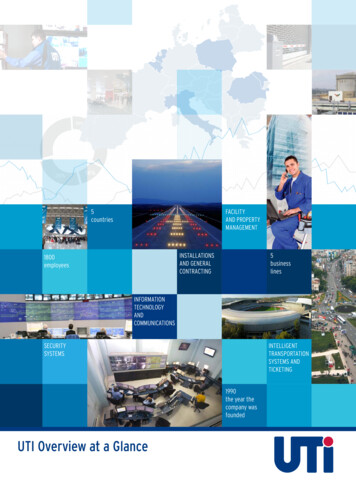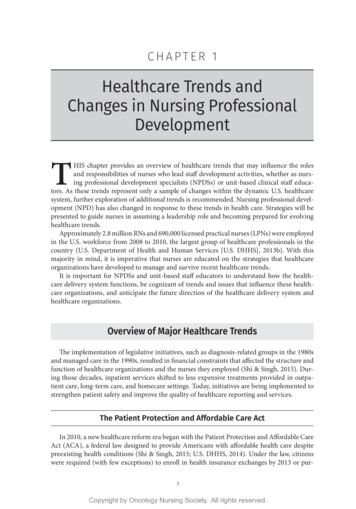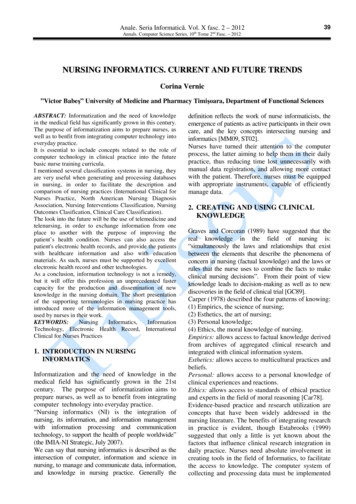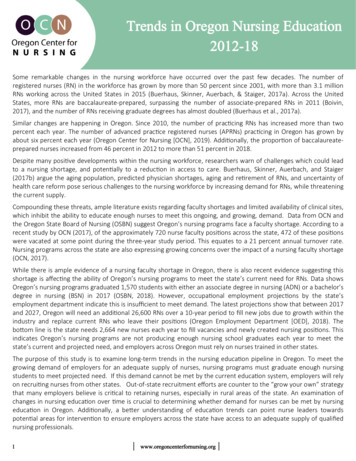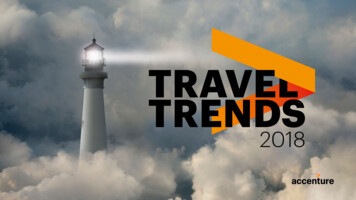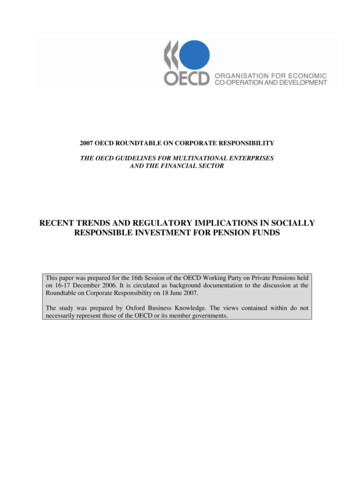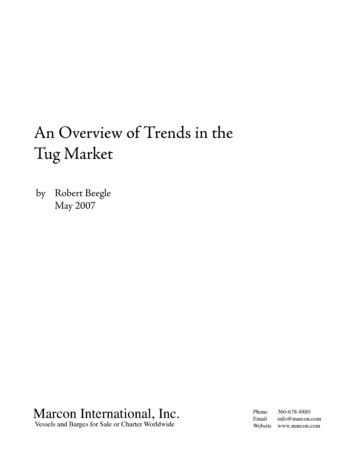
Transcription
An Overview of Trends in theTug Marketby Robert BeegleMay 2007Marcon International, Inc.Vessels and Barges for Sale or Charter comwww.marcon.com
An Overview of Trends in the Tug MarketMarcon International, Inc. has closely followed the tug market since 1981.While trends from yesterday created the towing industry we are familiarwith today, events now are shaping the tug market of tomorrow more thanat any other time in the past. Today’s trends indicate what the industry canexpect in the next 10 – 15 years. There have been many “ups” and “downs”,both for the industry and Marcon, since we sold our first tug in the early80’s. The best word though to describe the industry and the various trendswe are all experiencing today is “up”.Marcon sales are “up”. Charter rates and revenues are “up”. Utilization is “up”.Many owners report the highest level of activity and inquiries they have everseen. U.S. and overseas fleet sizes are “up”. Mergers and acquisitions are “up”.Tugs on order in the U.S. and worldwide are “up”. Horsepower is “up”. Pricesare “up” - which is great if you are a Seller. Of course, not everything “up” ispositive. Costs for fuel, machinery, steel, paint and labor are also “up”. Repaircosts are up. The average U.S. tug age is “up”. Government regulations andpaperwork are “up”. Prices for second-hand and new tugs are “up” - which isnot so great if you are a Buyer - and the present newbuilding frenzy meansfew slots are open for either fleet replacement or expansion. Even sistercompanies now compete head-to-head for equipment and newbuilding slots.Good equipment and personnel are scarce and operators turn down businessbecause of the lack of the right tug, barge or the people to man them. Onelocal operator, with all of his tugs working, describes himself as being“Boatless in Seattle”.The first tug sold by Marcon was the 85’,1800BHP “Big Brute” from Misener Marineto Alaska Marine Charters for use in DutchHarbor, Alaska.Like most companies involved with the towing industry, we have done verywell the last couple of years. Since we first opened our doors, Marcon hassold approximately 200 tugs totaling over a half a million BHP. Seventugs have been sold worldwide already this year, including two newbuilding 3,300BHP Robert Allan design ASD tugs now under construction inTurkey.Marcon Tug Sales and ChartersNumber of TugsTotal BHPAverage 02,1035,1772,0613,7704,3992,4884,3141
Revenues, Day Rates and UtilizationTug and barge prices are not the only thing that have increased. Revenuesare up. Many Owners report higher and sometimes even record earningsand day rates.Average Daily Rates or Time Charter EquivalentOperating revenues from Crowley’s Marine Services segment increased21.3% in 2006 compared to 2005. Hornbeck Offshore enjoyed improvedfourth quarter 2006 and record calendar 2006 results helped by tug-tankbarge revenues increasing 20.9% and day rates up 11% over the 2005 fourthquarter. K-Sea Transportation increased average dayrates for their tug-tankbarge fleet from 5,444 for the quarter ending 31 December 2005 to 6,644for the quarter ending 31 December 2006, while utilization improved from78% to 84% over the same period. Before Tidewater sold 14 tugs to Crosby,their U.S. fleet averaged 17,793 per day for the quarter ending September2006, almost triple the 6,028 per day earned the beginning of 2000.This upward trend is not limited to the United States. Last year was arecord year for Smit Internationale of Rotterdam as their 2006 net profitsnearly doubled over 2005. For Smit, the clouds definitely had a silver - or intheir case a golden lining, with a high volume of salvage work after the 2005hurricane season in the Gulf of Mexico and harbor towage in Rotterdamand Antwerp exceeding expectations due to strong winds in 2006.Paris-based Bourbon Group’s Towage & Salvage Division was up 4.3% forthe fourth quarter 2006 compared to the same quarter in 2005 and 12.9%over the year. Adsteam Marine increased their net profit for the second halfof 2006 by 22% compared to the previous year with their U.K. revenuesup 31% over the same time period. One European operator reported 2006average day rates for offshore and coastal towage in Northwestern Europewere nearly double the rates earned in 2005, increasing to approximatelyEuro 10-12,000 per day in 2006 from Euro 5-6,000 per day in 2005.2
Fleet SizeThere are more tugs operating worldwide today than at any time in thepast. One problem in reviewing statistics on tugs and other workboats indomestic and international markets is that we are always comparing “applesand oranges”. Our data comes from varied sources such as Lloyd’s Register,the U.S. Coast Guard, U.S. Army Corps of Engineers and others. Althoughthere are gaps in information, numbers constantly changing and each database using different parameters, we can still get a good idea of the trends.While information in Lloyd’s Register only covers sea-going vessels over100 gross register tons, there are many tugs either under that tonnage or ininland service. According to Lloyd’s, as of January 2007, there were 11,760“sea-going” tugs over 100GRT worldwide with a total of 28,116,599BHPand an average year built of 1983. Even taking into account flags of convenience, the largest national fleet of tugs worldwide sail under U.S. registry.We operate 1,427 “sea-going” tugs, or 12.1% of the world market, totaling4,140,961BHP (14.7% of the global horsepower). Since January 2001, theU.S. tug count is up 35.5% from 1,053 vessels. Total horsepower in the U.S.during that same period of time increased over one million horsepower from3,018,359BHP. The only negative is that the average age of U.S. sea-goingflag tugs over 100GRT also increased from 30 to 34 years.Starting out in Edward Lloyd’s 17th century London coffee house, Lloyd’s Registermaintains a database of over 80,000 ships,including movements, casualties, vessel characteristics and owners. In 1760, the RegisterSociety was formed by the coffee housecustomers and it printed the first “Register ofShips” in 1764.Average horsepower of each tug increasedfrom 2,867 to 3,326 BHP. Of the 1,427 U.S.flag tugs in Lloyds, 487 (43%) are powered byEMD’s, 21% by CATs, 14% by General Motors / Detroit Diesels. Fairbanks still powers6% of the fleet, mostly in older tugs.Following is a breakdown of the U.S. sea-going tug fleet by horsepower.Note that Lloyd’s only has data on 97 tugs under 999BHP. As most of the“under thousand horsepower” class of tugs in the U.S. are below 100 grossregister tons, they are not included in the Registry. In reality though, thereare eight to nine hundred small tugboats in this horsepower range workingdaily in U.S. coastal waters.U.S. Sea-Going Tug Fleet Over 180 GRT by BHP According to Lloyds RegisterUnknownBHPUnder9991000- 19992000- 29993000- 39994000- 49995000- 59996000- 69997000- 79998000- 89999000Plus182973162892061466145433391,427Avg. 3613,326Avg. 141.0Avg. g. Depth12.811.111.712.914.114.117.017.817.917.522.9# Single otal ## Twin/Triple ScrewAvg. Year BuiltTotalAll dimensions in feet and tenths. Sub-types where provided by Lloyds, break down to 21 anchor handling; 75articulated; 38 firefighting; 26 pusher; 3 recovery; 4 salvage; 4 offshore industry; 1,044 towing, arranged for pulling;10 twin-hull and 99 water-tractor.3
Data on U.S. flag tugs is also available from the U.S. Coast Guard “MerchantVessels of the United States” and U.S. Army Corps of Engineers “WaterborneTransportation Lines of the United States”, however here also, we end upcomparing “apples and oranges”. Sometimes databases lump both tugs andinland river pushboats together into one category as “Towing Vessels”. As ofa 31st December 2005 survey (with updates through 30 August 2006) theU.S. Army Corps of Engineers reported a total self-propelled U.S. fleet of8,976 vessels of which 5,290 or 58.9% were “towing vessels”. Approximately30.3% of the self-propelled fleet were tugs and 28.7% were true tow or pushboats – demonstrating the size and importance of the towing industry tothe U.S. economy. As of March 2007, the U.S. Coast Guard reported 6,871registered towing vessels in the U.S. – including both tugs and pushboats,with an average year built of 1971. This compares to 5,451 vessels with anaggregate horsepower of 7,273,219HP six years ago.Average Age of TugboatFleet in 2005Under 5 years1846 - 10 years18211 - 15 years7516 - 20 years8421 - 25 years392Over 25 years1,797Total2,717Credit: U.S. Army Corps of EngineersSummary of U.S. Towboat Fleet as of 2,717TotalTotal HPAverage 711,9121,8841,887Credit: U.S. Army Corps of EngineersAs of March 2007, the U.S. Coast Guard’s “Merchant Vessels of the UnitedStates” database included eight 2007 built ”towing vessels”, only a smallportion of those under construction. Offsetting these eight new boats inthe U.S. fleet are nineteen towing vessels launched before the turn of the lastcentury. The oldest tug in active service in the U.S. is the 68’ single screw“Sisters” (ex-“Fanny J”) owned by Hartley Marine out of Boothbay, Maine.She was built in 1874, nine years after the end of the Civil War, as the“Rebecca” and constructed of iron when the trend for most boats her sizewas to be built of wood. Originally powered with coal-fired steam, sheworked in Philadelphia for nearly ninety years. Now propelled by a singleGM12V71 swinging a four foot diameter bronze prop, she still earns herkeep docking a cement barge, towing construction barges and assisting in thelaunching of the latest trend of tugs built at Washburn & Doughty.We have come a long way in the 133 years since the steam screw tug“Rebecca” slid down the ways. Many U.S. tugs have been built, worked andeventually sold abroad or scrapped over the years. We have seen coal-firedsteam engines shift to oil-fired, diesel, diesel electric and soon-to-be hybridpropulsion; kort nozzles, steerable nozzles, shutter rudders; twin, triple4
and even quad-screws - plus a whole alphabet of types from ASDs, ATBs,Catugs, Combi’s, ITBs, Mor-Tracs, RTs (Rotor Tugs), SDMs (ShipdockingModules) and VSTs (Voith-Schneider tractors) to Robert Allan Z-Techs.NewbuildingsAn article in the April 4th 2007 issue of “Lloyds List Special Report on TugDesign & Construction” by Jack Gaston is titled “Demand Hits UnprecedentedLevels” and starts out saying “at no time in its 175-year history has the tug business experienced such an intense and sustained period of tug construction.” Weagree. The level of tug construction, both in the United States and abroad,is one of the trends that is “up”. Today’s dramatic flurry in new constructioncannot be explained by any one factor, but instead by a number of forces thatnormally do not all come into play at the same time.Ports worldwide require higher horsepower, more maneuverable dockingtugs to handle the increasing size of container ships, car carriers and tankers. New and expanding LNGprojects and oil terminals neednew specialized escort tugs. NewOPA’90 double skin tank barges inthe United States require higherhorsepower tugs to work them –plus more owners are now looking tousing ATBs instead of towing on thehawser.The tugs of tomorrow have to bemore efficient – efficient in operation, manning, maintenance and fuelconsumption. Refurbishing oldertonnage can no longer fulfill all ofthe needs for the future. Older tugswere designed to operate with fiveto eight man crews. Depending on the trade, tugs today are being designedto operate with anywhere from two to six crew. This is necessary, not onlyas a cost savings, but because of the extreme shortage of qualified personnel. While I do not expect to see an “Unmanned Tug” in my lifetime, moreautomation is required, not only in the engineroom, but on deck. When youalso take into consideration the pressure for a reduction in fuel consumptionand control of emissions; the past practice of converting old tugs to meetthe standards of today and the future may become a less attractive option,especially for shipdocking.5
The tugs being ordered and operated today include very diverse types, butgenerally can be broken down into five categories – with, of course, someblurring of lines between various designs and trades. Harbor / Shipdocking and Terminal Escort TugsATBs / ITBsConventional Ocean and Coastal TugsAnchor Handling TugsSalvage Tugs / ETVs / High Horsepower Ocean TowingHarbor / Docking and Terminal Escort TugsHarbor / shipdocking and terminal escort tugs dominate the newbuildingscene – both in the U.S. and abroad. Almost half the tugs on the orderbooks in the U.S. are for shipdocking and/or escort service. These arenot being built as a simple replacement of existing, older designs, butto meet new requirements. Eversince the Staten Island ferry“Nautilus” supplemented her revenues moonlighting by towing sailingships through the Narrows in 1818,the demand has always been forhigher horsepower, better maneuverability and lower manning. Thisevolution by itself is nothing new.Pilots have always wanted “the biggestand the best”. The harbor tug slowlyevolved over the years from a simple single screw boat to an all-around twinscrew tug capable of coping with both shipdocking duties and traditionalroutine towing jobs. The “typical” harbor tug is now expanding to a morepowerful and maneuverable boat performing a variety of roles such as escort,firefighting, pollution control and even salvage operations in adjacent waters.We are today experiencing a technological revolution in tractor tugs equal tothe leap made in 1950’s and 60’s from single to twin screw boats.Most shipdocking tugs now on order are “compact” tugs under 85’ in length.They are capable of working in the tighter environs of busy harbors andterminals with fewer crew while still providing bollard pulls upwards of 60tonnes or more. Investment can be high, but an incentive is the savings inoperating costs. It is a delicate balance of paying the high cost of a new tugagainst potential savings, but harbor tugs operate in a competitive market.They are always fighting a downwards pressure on rates from shipowners.6
New construction may be the only way a tug owner in a modern port canprovide the necessary services, achieve the reduction in operating cost toremain competitive and hold onto their market share. Two new sophisticated “compact” tractor tugs can now do a job that might have taken four or fivetugs in the past. The one new tug will be more expensive, but it can operatewith crew costs that are less than half of a two conventional tug operationplus fuel and other expenses are also reduced.ATBsOrders for new ATBs are growing. “Push tugs” and barges are now usedworldwide in such countries as Sweden, Denmark, Japan and Brazil forvarious bulk dry and liquid cargoes, but by far the largest fleet of ITBs andATBs operating and under construction is in the United States. Thereare approximately 23 new ATB tugs under construction in the U.S., mostmarried to double-skin OPA’90 ocean tank barges. In addition to thesenewbuildings are a few conventional tugs, such as K-Sea Transportation’s6,500HP “Barents Sea” (ex-“Pete”), being converted from other services. Iam not here to sell you on the efficiencies of ATBs compared to towingon the wire, but as long as there is a need for large dry bulk and petroleumbarges, ATB conversion and construction will continue.Conventional Coastal and Ocean TugsIn comparison, the mid-horsepower range conventional coastal and oceantowing market is one sector where we have not seen much new constructionin the United States. Only an approximate 8% of the tugs on order in theU.S. are conventional ocean and coastal hawser tugs, although constructionof this type in Southeast Asia is strong. More sales of second-hand tugsworldwide take place in this market sector than any other, as Buyers usually have a little more flexibility in their requirements than in other trades.While there is a strong demand in the U.S. for conventional and oceantugs, most operators still find revenues may not warrant the cost of newconstruction. Four notable exceptions are Sause Bros., Dann MarineTowing, Western Towboat and FossMaritime. Marcon sees a continuedshortage in traditional coastal andocean going tugs over the next fewyears. As older conventional tugsworking single skin petroleumbarges or docking ships are replaced by higher horsepower ATBs, ASDs, ortractor tugs, many will be recycled to conventional coastal towing.U.S. Shipbuilding Contracts asof 1 Jan. 2007Large 1200Total4153* includes options and estimated deliveriesCredit: Colton Co.7
The barge market is one indicator which can point to future trends forconventional coastal and ocean tugs. Like the tug market, the U.S. marketfor second-hand flat deck and similar type barges is tight. There are manymore potential buyers of barges than sellers in the market and new bargeconstruction is only recently starting to pick up in the United States. Likeconventional tugs, ocean flat deck barges are a major portion of productionfor shipyards in Southeast Asia and China.The majority of ocean deck barges now forsale by Marcon are located in SoutheastAsia.Anchor Handling TugsAnchor handling tugs are in demand overseas and are regularly being builtin China, Southeast Asia, India and Germany up to 18,000HP. With theexception of Harvey Gulf International, most U.S. operators are buildingstraight supply or anchor handling tug supply vessels instead of anchorhandling tugs.Salvage Tugs / ETVs / High Horsepower Ocean TugsThe 1970’s were the “heyday” for big ocean salvage tugs. From 1976 to 1978,twenty-eight powerful tugs over 10,000IHP were built for such renownednames in the industry as United Towing, ITC, Safmarine, Fukada, Wijs muller, Bugsier, Smit, Svitzer, Petrobras, Tokyo Marine and Les Abeilles.A reduction of casualties in the 1980’s, competition from non-dedicatedresources such as anchor handling tug suppliers and falling earnings led tolean times. Many salvage tugs were sold off to second-tier operators or evenscrapped. The traditional concept of commercial tugs standing by salvagestations was revitalized in the 1990’s in a slightly different form throughout the U.K. and Europe because of environmental concerns at criticalgeographical areas. This createda market for dedicated large, highhorsepower ocean rescue / salvagetugs or Emergency Towing Vessels (ETVs) equipped to carry outyear-round rescue towing and firstresponse activities from the EnglishChannel to the Great Barrier Reef.New dedicated rescue tugs are being built throughout the world. We atMarcon welcome this revitalization. The first step in preventing oil pollution is to keep the oil in the ship and a strong towing and salvage industry isnecessary.In December 2006, the U.K. Maritime andCoastguard Agency renewed their contractwith Klyne Tugs Ltd. of Lowestoft to supplyfour ETVs which are on stand-by 24 hoursa day, 365 days a year to respond to shippingincidents in their area. Two are based in theEnglish Channel, at Falmouth and Dover tocover the South West approaches and theDover Straits respectively. “Anglian Monarch”at Dover is jointly funded and operated withthe French Government. Two are based atStornoway and Shetland Islands.Another surprising trend occurred as companies providing long distanceocean wet-tow of high-value barges, vessels and structures found a “silverlining” in the cloud over the rest
Tug and barge prices are not the only thing that have increased. Revenues are up. Many Owners report higher and sometimes even record earnings and day rates. Average Daily Rates or Time Charter Equivalent Operating revenues from Crowley’s Marine Services segment increased 21.3% in

